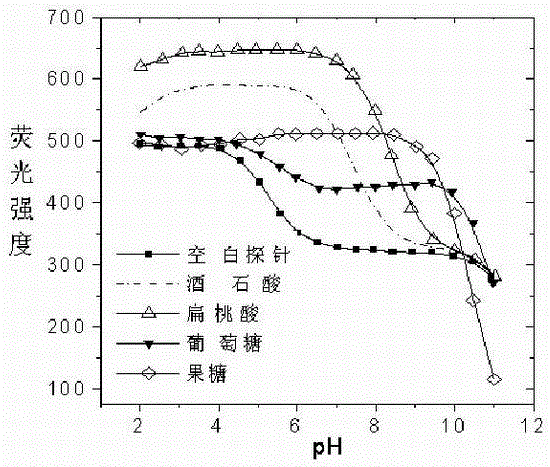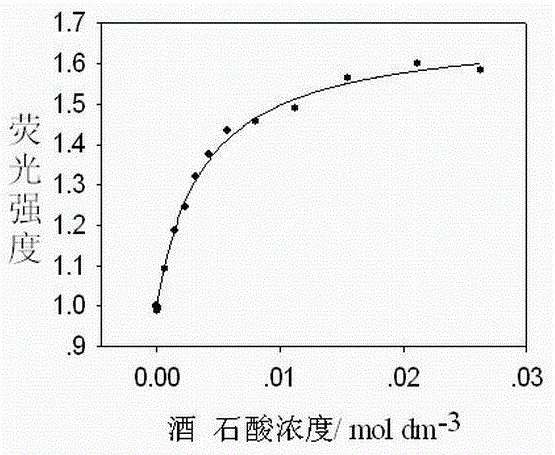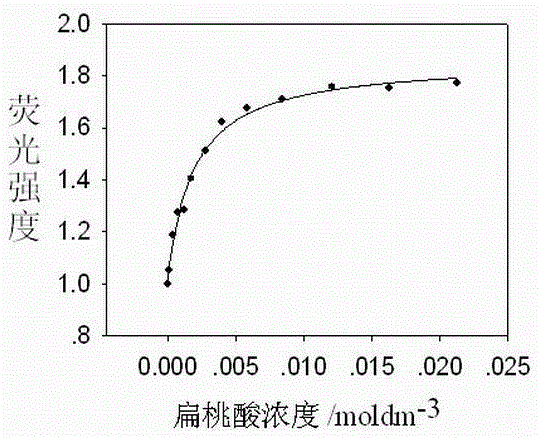A kind of boronic acid fluorescent molecular probe and its preparation method and application
A fluorescent molecular probe, boric acid technology, used in chemical instruments and methods, material analysis by optical means, analysis of materials, etc.
- Summary
- Abstract
- Description
- Claims
- Application Information
AI Technical Summary
Problems solved by technology
Method used
Image
Examples
Embodiment 1
[0047] The synthesis of embodiment 1 fluorescent probe compound 4:
[0048]
[0049] (1) Synthesis of compound 1
[0050] Add 2,4-dimethylpyrrole (3ml, 30mmol) and benzoyl chloride (2mL, 18mmol) into a 150mL two-necked flask, and stir at room temperature for three days. Add triethylamine (13mL, 90mmol), BF 3 ×Et 2 O (15mL, 120mmol), stirred at room temperature for one day. The solvent was removed under reduced pressure. Separation by column chromatography (silica gel column, developing solvent is dichloromethane). A deep red sticky substance was obtained, which was recrystallized in methanol to obtain 800 mg of a red solid. Yield 13%.
[0051] (2) Synthesis of compound 2
[0052] In a 250mL two-necked flask, ice bath, argon protection, add 10mL DMF, 10mL phosphorus oxychloride. Stir at room temperature for 30 min. Add 100mL of dichloroethane, 1 (474mg, 1.5mmol), and stir at 50°C for 3h. The solvent was removed under reduced pressure, and the residue was poured int...
Embodiment 2
[0057] Synthesis of embodiment 2 fluorescent probe compound 8:
[0058]
[0059] (2) Synthesis of Compound 5
[0060] Add 2,4-dimethylpyrrole (3ml, 30mmol) and 4-diethylaminobenzoyl chloride (3.8g, 18mmol) into a 100mL two-necked flask, and stir at room temperature for three days. Add triethylamine (13mL, 90mmol), BF 3 ×Et 2 O (15mL, 120mmol), stirred at room temperature for one day. The solvent was evaporated under reduced pressure. Separation by column chromatography (silica gel column, developing solvent is dichloromethane). A deep red sticky substance was obtained, which was recrystallized in methanol to obtain 650 mg of a purple solid. Yield 8.9%.
[0061] (2) Synthesis of Compound 6
[0062] In a 250mL two-necked flask, ice bath, argon protection, add 10mL DMF, 10mL phosphorus oxychloride. Stir at room temperature for 30 min. Add 100mL of dichloroethane, 5 (595mg, 1.5mmol), and stir at 50°C for 3h. The solvent was removed under reduced pressure, and the resi...
Embodiment 3
[0067] Synthesis of embodiment 3 fluorescent probe compound 12:
[0068]
[0069] (3) Synthesis of compound 9
[0070] Add 2,4-dimethylpyrrole (3ml, 30mmol) and 4-chlorobenzoyl chloride (3.2g, 18mmol) into a 100mL two-necked flask, and stir at room temperature for three days. Add triethylamine (13mL, 90mmol), BF 3 ×Et 2 O (15mL, 120mmol), stirred at room temperature for one day. The solvent was evaporated under reduced pressure. Separation by column chromatography (silica gel column, developing solvent is dichloromethane). A deep red sticky substance was obtained, which was recrystallized in methanol to obtain 720 mg of a purple solid. Yield 11%.
[0071] (2) Synthesis of compound 10
[0072] In a 250mL two-necked flask, ice bath, argon protection, add 10mL DMF, 10mL phosphorus oxychloride. Stir at room temperature for 30 min. Add 100mL of dichloroethane, 9 (540mg, 1.5mmol), and stir at 50°C for 3h. The solvent was removed under reduced pressure, and the residue w...
PUM
 Login to View More
Login to View More Abstract
Description
Claims
Application Information
 Login to View More
Login to View More - R&D
- Intellectual Property
- Life Sciences
- Materials
- Tech Scout
- Unparalleled Data Quality
- Higher Quality Content
- 60% Fewer Hallucinations
Browse by: Latest US Patents, China's latest patents, Technical Efficacy Thesaurus, Application Domain, Technology Topic, Popular Technical Reports.
© 2025 PatSnap. All rights reserved.Legal|Privacy policy|Modern Slavery Act Transparency Statement|Sitemap|About US| Contact US: help@patsnap.com



